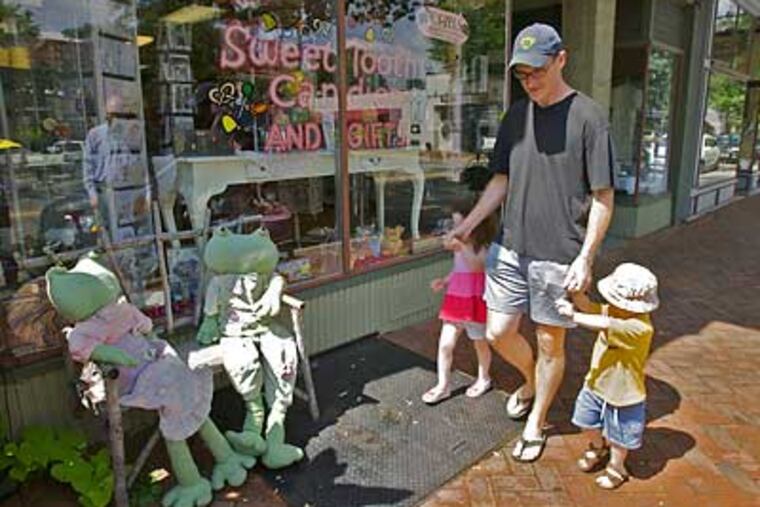Campaign will market older towns
The message: Close-in suburbs and less-known areas of Phila. can be good places to live, and cheaper.

An ordinarily low-profile agency known for dispensing planning advice is unleashing a marketing campaign to promote older towns as a viable alternative to living in the far-flung suburbs.
Today, the Delaware Valley Regional Planning Commission will launch a push to get people to move into inner-ring suburbs such as Collingswood and Lansdowne, or to Philadelphia's lesser-known neighborhoods.
It will do so with the help of nine boroughs in Pennsylvania and New Jersey and two city neighborhoods that the DVRPC has designated the inaugural "Classic Towns of Greater Philadelphia."
"We think the time is right that people rediscover these kinds of communities," said Barry Seymour, executive director of the DVRPC - and someone who walks the talk as a resident of the Main Line inner-ring town of Narberth.
An official announcement is scheduled for 11:30 a.m. today at the Independence Visitor Center. Officials from each of the Classic Towns will attend.
The selected Classic Towns represent the challenges and potential of the region's older communities, said Alison Hastings, an environmental planner with the DVRPC.
They are places that have been long suffering as homebuyers the past few decades have opted for more spacious homes on large lots in new subdivisions on the suburban fringe.
The result has been crippling to the region's so-called first suburbs, left to struggle with declining population, aging infrastructure, and loss of industry that once bolstered their tax base.
All the Classic Towns - the boroughs of Ambler, Bristol, Collingswood, Doylestown, Haddon Heights, Lansdowne, Media, Riverton and West Chester, along with Philadelphia's Manayunk and Overbrook Farms neighborhoods - have made significant comeback strides with a variety of revitalization efforts.
What they - and nearly 100 older communities like them in this region - now need is a way to get the word out that they are worth considering as a place to live, Hastings said.
Beyond offering promotional advice to those towns, the planning commission hopes to inspire more investment in them with educational outreach to the finance industry, community-development professionals and the general public.
That takes money. Consequently, one of the conditions of participating in the Classic Towns program - whose start was enabled by a $250,000 grant from the William Penn Foundation - is an annual contribution of $2,500 from each town. The fee will be matched by the DVRPC.
The combined annual pot of $55,000 will be used to advertise the Classic Towns and help cover the cost of a promotional Web site also set to debut today: www.phillyclassictowns.com.
Organizers already have worked up a sales pitch that plays off the budget-busting gas situation: If you live in these walkable mixed-use communities with convenient access to public transit, you probably can get rid of at least one car in your driveway.
While planners have been advocating for years a return to older communities as a way to curb suburban sprawl, Seymour said, "I think now with gas prices, the market is finally catching up to those policy objectives."
Hallelujah is the response in Collingswood, population 14,220, which has watched the blight from Camden creep ever closer.
Borough leaders took a big gamble in the mid-1990s with an $8 million bond - just about the size of Collingswood's budget - to buy a 45 percent stake in the massive Sutton Towers apartment complex. The 1,000-unit facility, the town's largest taxpayer, was more than half vacant and its owner bankrupt.
Now, the 10-story towers are renovated and brimming with residents. The turnaround "changed people's perceptions" and "made them believe we would not go the way of Camden," Mayor M. James Maley said.
Maley said last week that the decision to put up the $2,500 fee for Classic Towns was a "no-brainer."
That opinion is shared by Jayne Young, mayor of Lansdowne, a Delaware County community of 10,861 residents, with a downtown that in 2004 was determined to have met the state's definition of blight.
Town leaders have fashioned a redevelopment plan for the business district and adjacent neighborhoods. The plan calls for converting many of the tired shopping centers along Baltimore Avenue into mixed-use complexes of retail on the street level, topped with apartments and condominiums.
But getting the word out is a problem for cash-strapped older communities, Young said.
In Philadelphia's Overbrook Farms, homeowners association president Terry Henry said the Classic Towns buy-in "was a stretch for us" considering the group's annual budget of $12,000, used primarily for neighborhood beautification.
But Henry is hoping to leverage that contribution into additional funding from the planning commission. Indeed, DVRPC officials say Classic Towns will be given priority status for transportation and community development planning grants. Henry said the Overbrook Farms homeowners association wants funding to pay for a comprehensive traffic and parking plan for the neighborhood of about 400 homes dating from 1896.
Situated close to City Avenue, it is a little-noticed community of 3,000-square-foot-plus homes of stunning architecture, slate roofs and stained-glass windows.
"We think that the Classic Towns program will help shed some light on . . . one of the hidden jewels of Philadelphia," Henry said.